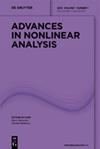通过连续周期切换模型模拟蚊子种群沃尔巴克氏体感染频率
IF 3.7
1区 数学
Q1 MATHEMATICS
引用次数: 2
摘要
本文通过释放感染沃尔巴克氏体的蚊子,建立了一个连续的周期切换模型,描述了沃尔巴克氏体感染在蚊子种群中的频率动态,这与文献中离散建模的努力不同。我们得到了一个唯一的和恰好两个周期解存在的充分条件,并分别分析了每个周期解的稳定性。我们还提供了简短的讨论和几个数值例子来说明我们的理论结果。本文章由计算机程序翻译,如有差异,请以英文原文为准。
Modeling Wolbachia infection frequency in mosquito populations via a continuous periodic switching model
Abstract In this article, we develop a continuous periodic switching model depicting Wolbachia infection frequency dynamics in mosquito populations by releasing Wolbachia-infected mosquitoes, which is different from the discrete modeling efforts in the literature. We obtain sufficient conditions on the existence of a unique and exactly two periodic solutions and analyze the stability of each periodic solution, respectively. We also provide a brief discussion and several numerical examples to illustrate our theoretical results.
求助全文
通过发布文献求助,成功后即可免费获取论文全文。
去求助
来源期刊

Advances in Nonlinear Analysis
MATHEMATICS, APPLIED-MATHEMATICS
CiteScore
6.00
自引率
9.50%
发文量
60
审稿时长
30 weeks
期刊介绍:
Advances in Nonlinear Analysis (ANONA) aims to publish selected research contributions devoted to nonlinear problems coming from different areas, with particular reference to those introducing new techniques capable of solving a wide range of problems. The Journal focuses on papers that address significant problems in pure and applied nonlinear analysis. ANONA seeks to present the most significant advances in this field to a wide readership, including researchers and graduate students in mathematics, physics, and engineering.
 求助内容:
求助内容: 应助结果提醒方式:
应助结果提醒方式:


